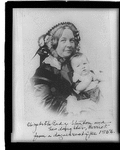Elizabeth Cady Stanton and Women's Liberty
by Kathryn Cullen-DuPont
From Chapter One: "The Brink of a Precipice"
May 10, 1840 was a Friday, an allegedly unlucky day to enter the state of matrimony. But Elizabeth Cady refused to worry. The day before, she'd finally decided to marry Henry Stanton; she would have married him that same afternoon, an uncontroversial Thursday, but Mr. Stanton's journey to her side via the North River (as the Hudson was then called) had been slowed by a sandbar.
His courtship of her had earlier faced its own impediments: he was a well-known abolitionist, that is, a person committed to working for an end to slavery and the granting of U.S. citizenship to black people in America. Many people held antislvery views that were more limited than the views held by abolitionists; for example, while some antislavery people felt that slavery was morally wrong, they nevertheless made no claims for the equality of black and white human beings and offered colonization--the deportation of black men and women to Africa or other destinations--as a way to rid the United States of slavery. Henry B. Stanton, then, as an abolitionist, belonged to the most radical segnent of the antislavery movement. He was known for his brave silencing of hostile mobs, and Elizabeth thought him a hero. Her conservative father, Judge Daniel Cady, did not. Moreover, Herny Stanton was penniless. When Elizabeth first became betrothed to him, Judge Cady and other members of the Cady family insisted that she break her engagement. She did, but she would not stop corresponding with the man she loved. Henry Stanton had, Elizathe thought, "one of the most eloquent pens of this generation." By letter alone, he was able to convince her of a future "as bright and beautiful as Spring." Then he wrote that he was going to Europe for several months as a delegate to the World Anti-Slavery Convention. Elizabeth despaired. As she later recalled, she "did not wish the ocean to roll between us." Asked once more if she'd like to marry, Elizabeth Cady said "yes." She and Henry would elope.
The Reverend Hugh Marie had agreed to marry the couple in secrecy, but he had not agreed to Friday nuptuals. Now he was begging them to wait. Tormorrow would be Saturday, he said, and much luckier. Elizabeth laughed. Henry Stanton was at her side, and a new life of love and freedom was about to begin. Friday's luck? She brushed that aside. Instead, she raised an objection of her own: to the marriage vow binding her "to love, honor and obey" her husband. "I obstinately refused," she later recalled in her autobiography, "to obey one with whom I supposed I was intering into an equal relation."
This was a shocking innovation in 1840. At the time, a man received control of a woman's body upon marriage: Once wed, a woman could not refuse her husband's sexual advances. The rare omission of "obey" from a bride's vows meant that she intended to grant or withhold consent according to her own desires. Henry Stanton, attending a wedding the year before, had heard another bride so refuse to "obey." Now he supported his own bride's wishes. The Reverend Marie, however, was very upset, and it was only at the end of a lengthy argument that he finally agreed to a Friday wedding with modified vows. Then, all obstacles to their union overcome, Elizabeth Cady and Henry B. Stanton were married.
Copyright 1992 by Kathryn Cullen-DuPont
